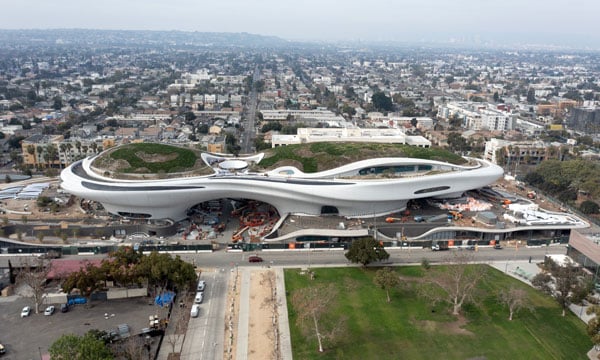The Billionaire Museum

The Lucas Museum under construction in Exposition Park in early 2025. (Eric Furle, Sand Hill Media / JAKS Productions)
On June 27, 2017, the Los Angeles City Council gathered to vote to approve a proposed museum in Exposition Park, whose construction and programming was to be funded by billionaire filmmaker George Lucas of Star Wars fame. For years, Lucas had tried to plant his namesake museum, which will gather his private collection of film memorabilia, illustration, painting and drawing, in other cities — San Francisco and Chicago. But LA greeted him with open arms and a prime piece of public land. City Council President Herb Wesson set the mood at the meeting by stating: “Let’s just applaud for the heck of it because this is a good day.”
The Council’s discussion centered largely on the museum’s programming. Then director Don Bacigalupi described education as residing “at the heart of the museum’s mission,” and proceeded to describe “a whole host” of programs geared at children of all ages. Later, when Mellody Hobson, the museum’s board co-chair (who also happens to be married to Lucas), took to the dais, she reaffirmed the commitment to education, noting that there were 100 schools within close proximity of the museum’s chosen site. “When we think about this museum, it's not just a museum,” she said, “it is a place where not only students and children and adults [will come], but schools and academics. People will come from all over the world to learn.”
Which is why I was curious to read a report in The Times late last month that the museum laid off 14% of its full-time staff — largely from the education department. This followed the departure of the museum’s director Sandra Jackson-Dumont in late February. Part of what had made Jackson-Dumont a compelling hire was her background in education: for five years prior to joining the Lucas she had run the education department at the Metropolitan Museum of Art. Now, with a year to go until the Lucas opened, Jackson-Dumont was gone and Lucas was appointing himself head of “content direction.”

The Lucas Museum's library under construction in 2023. (Roberto Gomez / USC School of Cinematic Arts)
Certainly, at the root of the problem is a muddled vision of what exactly the museum is supposed to be. As a former employee told Hyperallergic in late May, there has been a “core discrepancy between what George [Lucas] thinks a museum is and what the leadership thinks it is.”
From the get-go, Lucas has insisted on constructing a namesake museum from the ground-up in a major city. (No nice, renovated warehouses for him.) He has also insisted that it will focus on a grand category of art of his own description: narrative art, a.k.a. “visual art that tells a story.” Which sounds new, but is actually already a thing. In fact, it’s been a thing for thousands of years. And it is generally known by its format and medium, such as figurative painting, illustration, or sequential storytelling (which can include arts like comics or cinematic storyboarding).
I was skeptical of this absurd category when it was first announced. But as the museum progressed, I was intrigued by some of the appointments. The board brought on impressive leaders, such as LA curator Pilar Tompkins-Rivas, who has a solid track record of thoughtful and imaginative curation, as well as Jackson-Dumont. In this time, the museum also made some interesting, if eclectic acquisitions: from a Frida Kahlo self-portrait to preparatory drawings for an important LA community mural led by Judy Baca to a painting by satirist Robert Colescott. “Narrative art,” it seems, is simply stuff Lucas likes. (Blogger William Poundstone has been trying to make sense of the hodgepodge.)

Robert Colescott, George Washington Carver Crossing the Delaware River: Page From an American History Textbook, 1975. (Lucas Museum of Narrative Art / Robert H. Colescott Separate Property Trust / ARS)
But the dismissal of much of the education team — after going on and on about how education would be at the core of the institution — along with the fact that Lucas has now installed himself as the museum’s Dear Leader has sent my skepticism meter off the dial. In a recent report about the museum’s troubles in the New York Times, former MOCA curator Paul Schimmel said that museums often bear the stamps of their wealthy founders, like the Norton Simon in Pasadena or the Huntington in San Marino, founded by rail magnate Henry Huntington. “The uniqueness of each of these collections makes for something that’s remarkable,” he said. “If George Lucas needs to be the director to get this thing done, so be it.”
A fine idea in theory, except that Huntington didn’t demand public land for his project. And a billionaire in a room full of yes-men is not exactly the ideal condition in which to produce a compelling story of art. That is, after all, how we ended up with Jar Jar Binks.